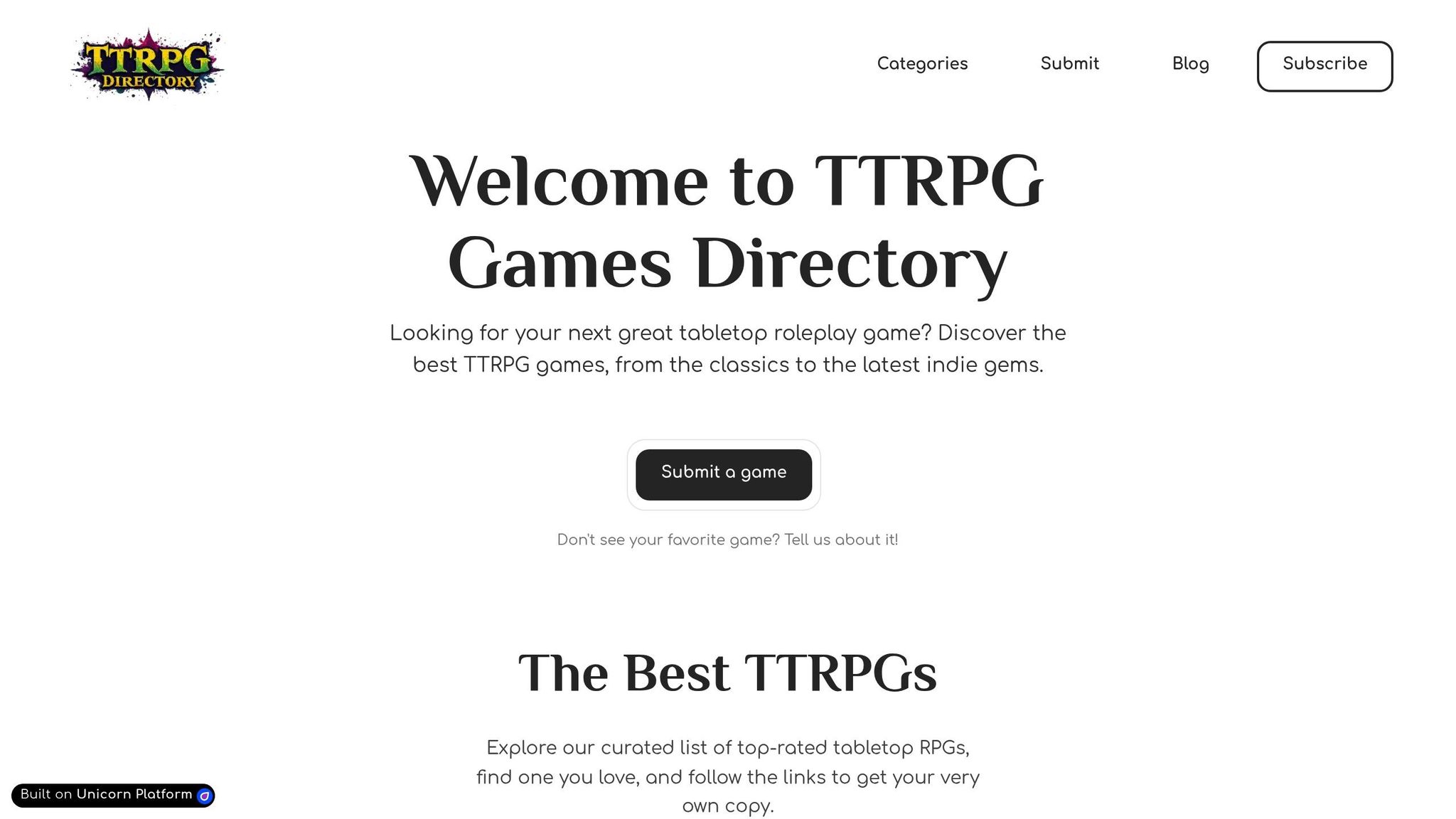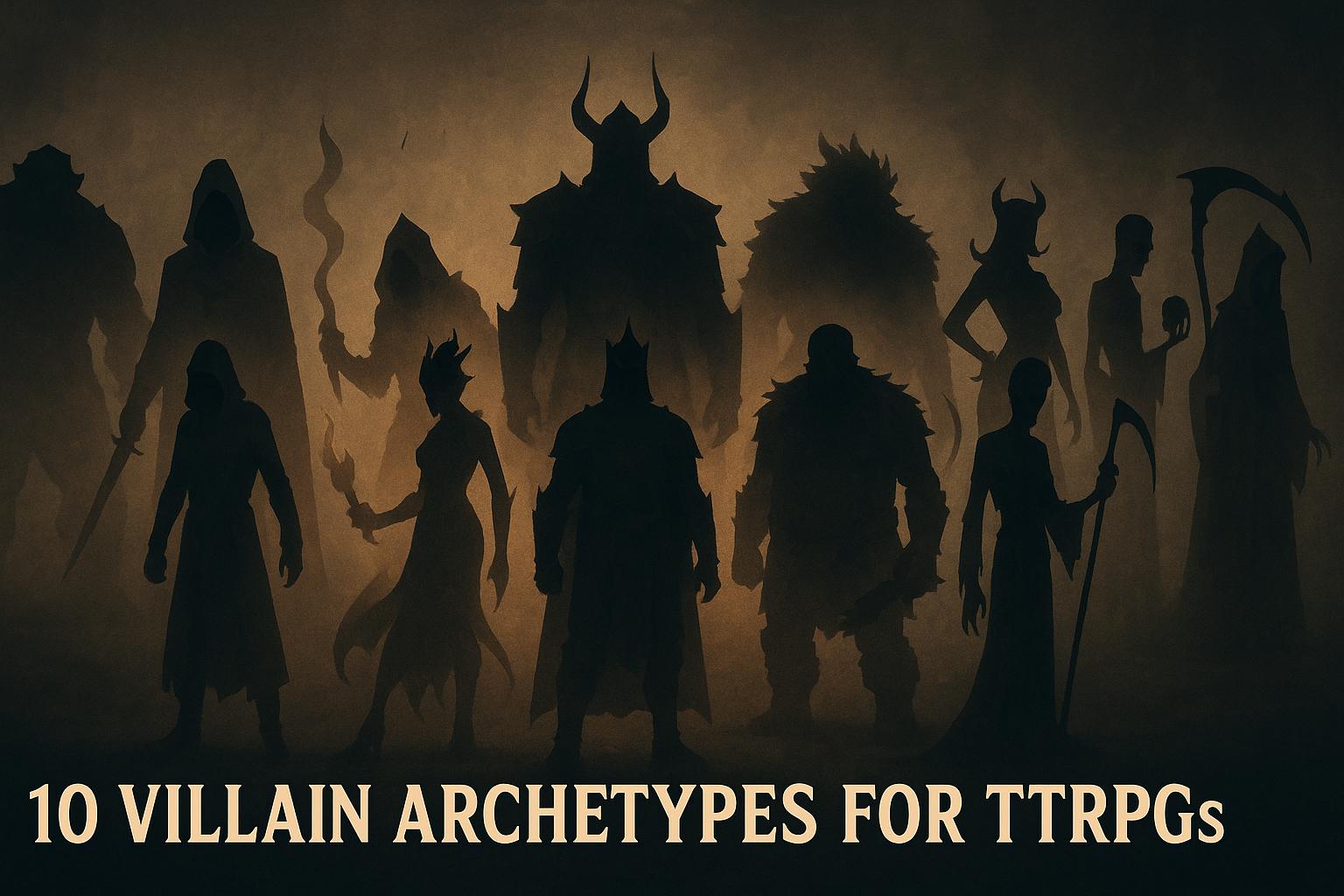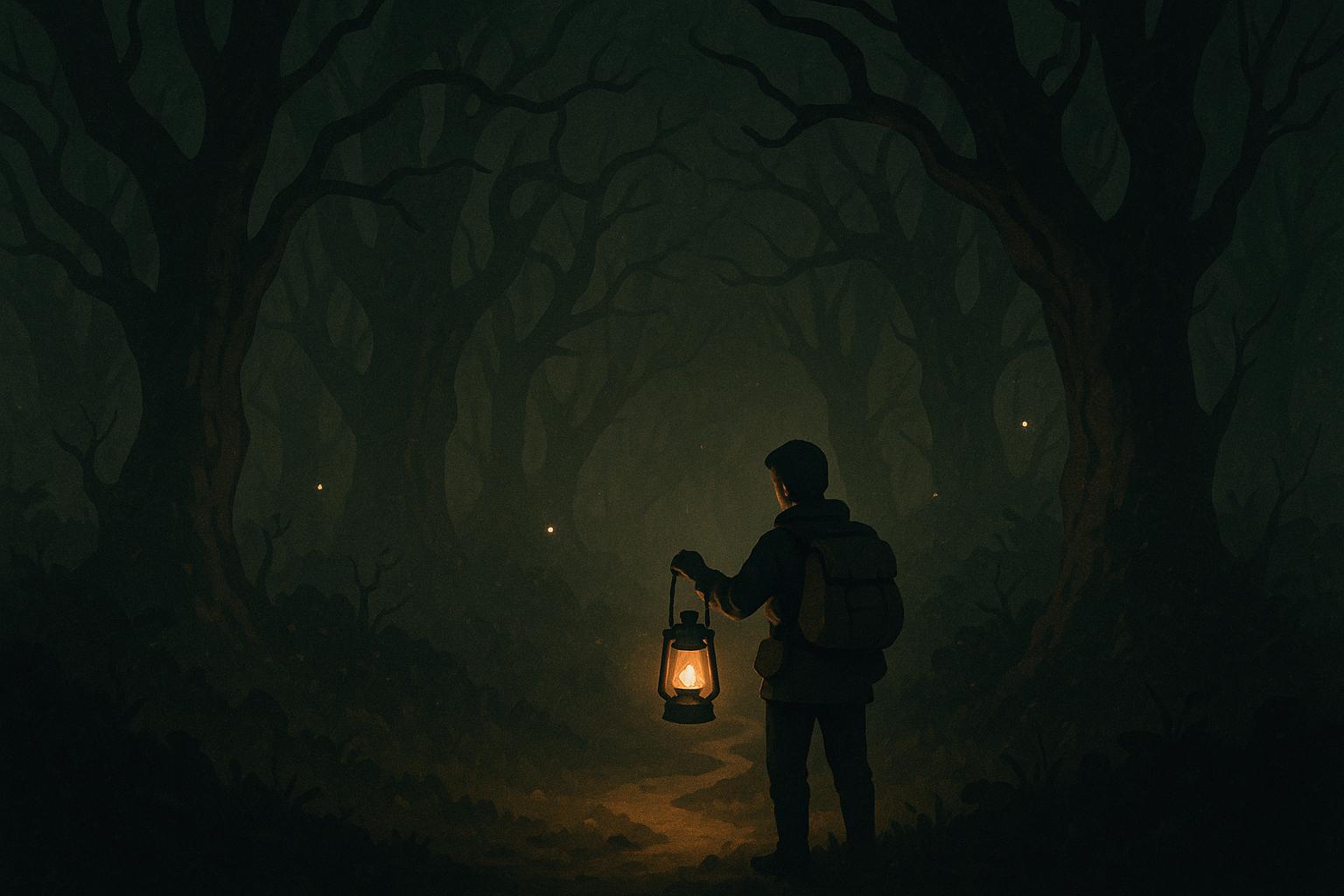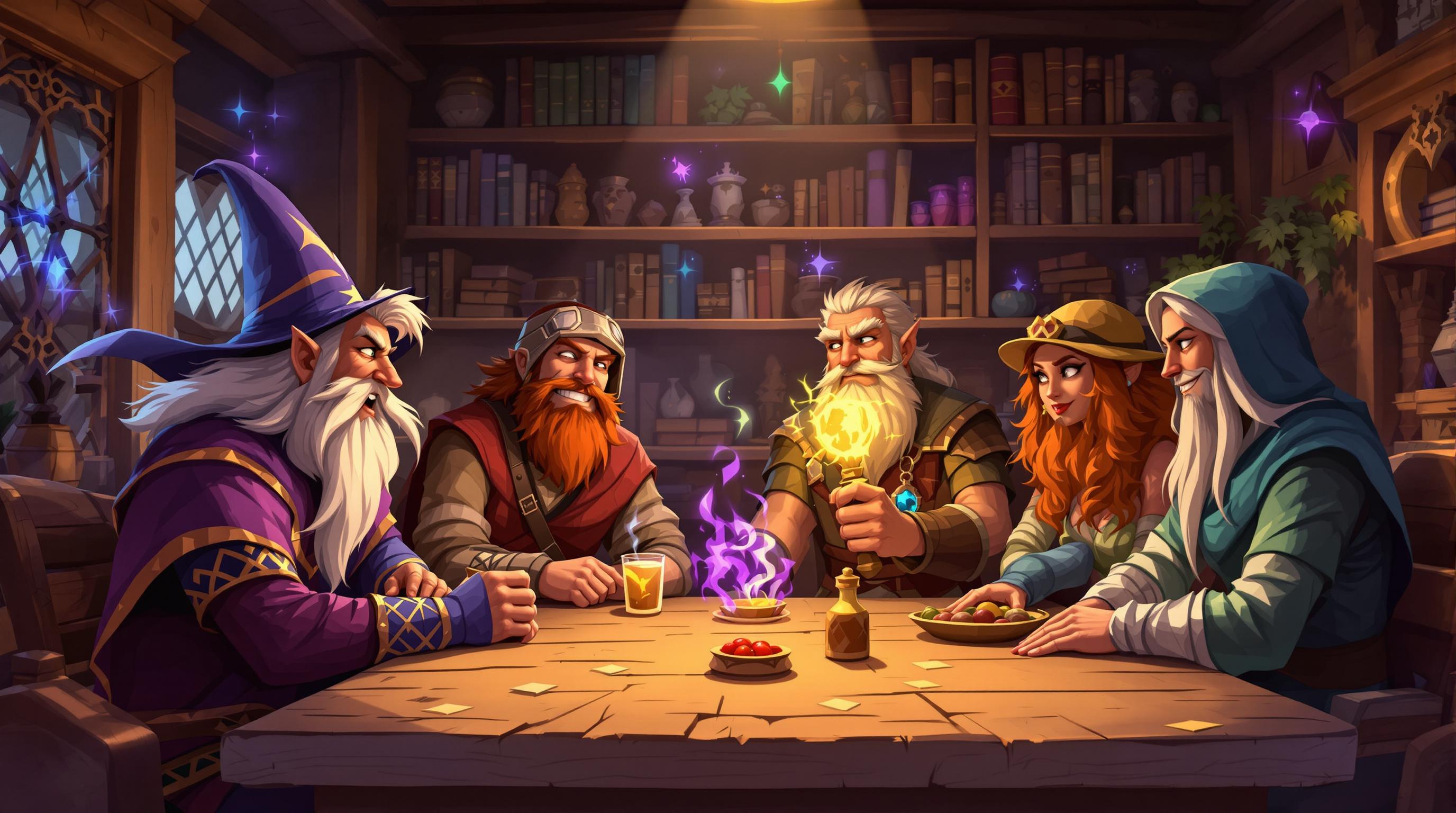Folklore adds depth to RPG campaigns, offering rich stories, creatures, and themes for immersive world-building. It connects players to timeless narratives while introducing moral challenges and emotional resonance. To use folklore effectively, focus on:
- Researching reliable sources: Use academic archives, folklore collections, and primary texts to ensure accuracy and respect.
- Respecting traditions: Understand the origins and meanings of myths, consulting experts when working with unfamiliar stories.
- Integrating folklore into gameplay: Build quests, NPCs, and magic systems around folkloric elements, making them integral to the world.
- Balancing creativity and respect: Adapt myths thoughtfully, preserving their essence while aligning with your game’s mechanics.
This approach ensures folklore enriches your campaign without losing its original significance.
Finding Reliable Folklore Sources
Selecting trustworthy sources is crucial when incorporating folklore into your campaigns. Reliable materials ensure your storytelling stays respectful and avoids perpetuating stereotypes. While the internet offers a wealth of folklore content, not everything you’ll find online can be trusted. For accuracy and cultural sensitivity, academic institutions and established folklore archives are some of the best options.
Primary sources, such as original collections, archival records, and audio recordings, provide rich details that can enhance your world-building. On the other hand, secondary sources - like scholarly articles and analyses - offer valuable insights into the meanings and patterns behind traditions.
Key Sources for Folklore Research
Academic institutions are a cornerstone for folklore research. University folklore departments uphold high standards of accuracy and cultural respect, making them a reliable resource for creators aiming to stay true to the original beliefs and practices.
The Library of Congress Folklore Collections stands out as one of the most extensive archives. It includes field recordings, historical texts, and photographs that preserve cultural narratives in their original context. These materials can help you understand not just the "what" of folklore but also the "why" behind its development within specific communities.
Project Gutenberg is another excellent resource, offering free access to historical folklore texts in the public domain. Many of these works, dating back to the 19th and early 20th centuries, capture traditions before they were influenced by modern reinterpretations.
Academic journals specializing in folklore studies are invaluable for deep dives into cultural narratives. These peer-reviewed publications often include contributions from scholars who belong to the cultures being discussed, providing perspectives that go beyond Western-centric interpretations.
Digital archives and databases have made folklore research more accessible than ever. Materials that were once confined to universities are now readily available, giving creators a chance to explore a wide range of traditions.
When working with these resources, pay close attention to metadata, which can provide critical context about the origin and cultural significance of the material. This ensures that sacred or meaningful traditions are handled with care and respect.
Checking Folklore Accuracy
Once you’ve gathered your sources, it’s important to verify the details to ensure both authenticity and respect. Aim to cross-check information with at least three reputable sources. This process helps identify commonalities in descriptions of creatures, myths, or rituals, while also revealing genuine regional variations.
Pay attention to publication dates and author credentials. More recent works often reflect updated scholarship and nuanced perspectives, whereas older texts may carry biases that are no longer appropriate.
Understanding the original purpose of folklore - whether it was meant to explain natural phenomena, teach moral lessons, or preserve history - can guide how you portray these traditions. This distinction is crucial for separating authentic folklore from modern adaptations shaped by popular culture.
Finally, document your sources and the reasoning behind each adaptation. Keeping a research log not only ensures consistency in your world-building but also provides transparency for your players. When exploring folklore from cultures outside your own, prioritize scholarly works by academics from those communities. This approach helps avoid the pitfalls of relying solely on Western interpretations, ensuring a more respectful and accurate portrayal.
Adapting Folklore for RPGs Respectfully
When incorporating folklore into role-playing games (RPGs), it’s important to treat these stories with the respect they deserve. Folklore often carries deep cultural significance, and adapting it thoughtfully can create meaningful gameplay experiences that honor its origins. The goal here isn’t just to avoid missteps - it’s to celebrate the depth and richness of these traditions while crafting engaging game content.
Being Sensitive When Adapting Folklore
To adapt folklore respectfully, it’s essential to understand the cultural roots of the stories you’re working with. Many tales are more than just entertainment; they often hold spiritual, historical, or social importance. For example, Native American legends frequently carry sacred teachings. Reducing them to simple game elements like monsters or quest hooks risks stripping away their deeper meanings.
Understand the original purpose of the folklore. Was the story meant to teach a moral lesson? Explain a natural phenomenon? Preserve historical memory? Knowing its intent helps you decide which elements can fit into a game without losing their integrity.
Seek input from cultural experts. If you’re adapting folklore from a community you’re not part of, consult with individuals who are. This isn’t a one-time task - ongoing collaboration ensures you’re staying true to the material. For instance, working with Māori consultants can clarify which stories are appropriate to adapt and which are considered sacred and should remain untouched.
Avoid reducing traditions to stereotypes. Trickster spirits, for example, aren’t just mischievous troublemakers - they often play complex roles as wisdom bearers or cultural icons. Representing them with depth not only enriches your game but also respects their traditional significance.
It’s also crucial to consider power dynamics. If you’re drawing from marginalized communities, extra care is needed to avoid perpetuating harmful misconceptions or erasing cultural identity. Be transparent about your research process, and document your sources to show accountability.
Lastly, compensate and credit cultural consultants for their expertise. Acknowledging their contributions - whether through credits or bibliographies in your game - demonstrates respect and encourages players to explore the original stories further.
Balancing Accuracy and Game Needs
Once you’ve approached folklore with sensitivity, the next step is balancing authenticity with the practical needs of your game. The key here is to preserve the essence of the story while adapting it to fit your game mechanics.
Focus on the core themes of the folklore. If a myth revolves around transformation and personal growth, your game mechanics could emphasize character development and moral decision-making instead of just combat. This approach keeps the heart of the story intact while aligning with gameplay needs.
Tolkien’s work in Middle-earth is a great example of this balance. Drawing from Norse and Anglo-Saxon motifs, Tolkien created something new while respecting the spirit of the source material. His elves, for instance, aren’t identical to Norse álfar, but they retain similar themes of wisdom and a deep connection to nature.
Reimagine folklore elements in new contexts. If a direct adaptation doesn’t fit your game world, consider creating inspired-by versions. For instance, instead of placing a Greco-Egyptian sphinx in a Nordic setting without explanation, craft a unique creature that aligns with your world’s logic while drawing inspiration from the original.
Maintain narrative consistency. If your game incorporates folklore from multiple traditions, establish clear reasons for their coexistence. Perhaps different regions developed distinct mythologies, or ancient migrations brought these traditions together. This consistency helps create a believable and immersive world.
Playtest with diverse groups, especially with people from the cultures you’re drawing from. Their feedback can help you identify unintentional biases or misrepresentations, ensuring your game feels inclusive and respectful.
When game mechanics clash with folklore, focus on preserving the story’s emotional core rather than sticking to every literal detail. For example, a Japanese yokai might need adjusted abilities to fit your game system, but its role as a supernatural reflection of human fears or desires should remain intact.
Thoughtful adaptation is about interpretation, not appropriation. By approaching folklore with care and creativity, you’re building something new inspired by these traditions - not claiming ownership over them. Many RPGs, showcased in resources like the TTRPG Games Directory, offer excellent examples of how to handle folklore with respect while crafting compelling gameplay.
Adding Folklore to RPG Mechanics and Storytelling
Once you’ve done the research and found a respectful way to adapt folklore into your campaign, the next step is weaving those elements into the game’s mechanics and story. This isn’t just about tossing mythical creatures into random encounters. It’s about building a world where folklore shapes everything - how characters interact, how magic works, and even how the world itself feels alive. Let’s dive into how you can make folklore an integral part of your RPG experience.
Using Folklore Creatures and NPCs
Folklore creatures work best when they’re more than just an isolated combat challenge. They should feel like they belong in the world, influencing the local culture and everyday life. Take a banshee, for example. Instead of being just another monster to fight, her presence could shape how villagers behave after dark, fuel local superstitions, and carry emotional weight tied to regional legends.
When introducing folklore-inspired NPCs, stay true to their mythic roots while giving them clear motivations that drive the story. Think of a wise woman from Slavic folklore - a healer and keeper of secrets. Her speech, customs, and relationships should reflect the traditions you’ve researched, making her feel like a natural part of the world.
Let’s say you’re adapting a rusalka, a water spirit from Slavic tales. How does it interact with the local ecosystem? Why does it haunt a specific lake or river? How does its presence affect nearby wildlife or human settlements? These details encourage players to engage with the creature through exploration and problem-solving, not just combat.
Trickster spirits are another fantastic addition. They don’t have to be simple troublemakers; they can challenge players’ morals, serve as quirky mentors, or even kick off quests. Picture a coyote-inspired trickster who offers important information - but only after testing the party in unexpected ways. The goal is to make these figures feel like they belong in your world’s mythology, not like random additions.
Once you’ve set the stage with these culturally rich characters, you can use folklore to inspire quests and rituals that deepen the narrative.
Creating Folklore-Based Quests and Rituals
Folklore-based quests often draw on timeless story patterns - think the hero’s journey, forbidden knowledge, or moral tests. These themes are universal, so they naturally resonate with players.
Imagine a quest tied to a solstice festival. The party needs to recover a lost artifact, but the task is woven into the festival’s rituals, the power of seasonal transitions, and the significance of sacred objects. This approach connects player actions to the larger mythic cycles of the world.
Local customs and taboos can add depth to these quests. Maybe the players must appease a restless spirit, but the ritual is specific and meaningful. They might need to gather herbs at dawn, speak the spirit’s true name, or offer a cherished personal item. If they skip any steps, the consequences could mirror the kind of fallout found in traditional myths.
Rituals should involve active player participation. Instead of rolling dice to “complete the ritual,” have players recite chants, arrange symbolic objects, or make tough moral choices. Success might bring blessings or vital information, while failure could unleash curses or awaken ancient guardians. Seasonal festivals and celebrations can also serve as the backdrop for multi-session arcs. For instance, a harvest festival could begin with joy but slowly reveal underlying tensions or broken pacts.
Building Magic Systems and Artifacts
To make folklore-inspired magic feel authentic, tie it to the symbolic logic and rituals found in traditional beliefs. Magic in folklore is often unpredictable, morally complex, and deeply connected to nature’s rhythms. Treat it as something more than a tool - it’s a force that demands respect.
One common idea in folklore is sympathetic magic, where “like attracts like.” For example, a spell might require a lock of hair to influence someone, water from a sacred spring for healing, or iron nails to fend off evil. Timing can also play a role - certain spells might only work during specific moon phases, at dawn, or during seasonal shifts. This adds a natural rhythm to magic and encourages players to plan ahead.
Adding moral consequences and unpredictable side effects makes magic even more engaging. A healing spell might cure an illness but subtly harm the local ecosystem. A divination ritual could reveal critical truths but also attract dangerous entities determined to keep some secrets hidden. These complications reinforce the idea that magic always comes at a cost.
Artifacts can also bring folklore to life when they’re tied to specific legends and have unique conditions for use. Take the Hand of Glory from European lore - it might unlock any door, but only when a special candle is lit and only if the user has met a specific requirement. These conditions can lead to mini-quests, encouraging players to explore the artifact’s history and meaning.
Different regions in your game world might approach magic in distinct ways. One culture might rely on elaborate ceremonies and ritual purity, while another uses natural materials and seasonal timing. This variety adds depth to your campaign, creating opportunities for cultural exchange - or conflict.
Finally, many TTRPG systems already incorporate folklore-based mechanics, like spirit summoning or curse dynamics. Studying these examples can provide inspiration for your own campaigns, helping you design mechanics that feel rooted in myth and legend.
sbb-itb-b8b00a5
Tools and Resources for Folklore Research
When it comes to crafting campaigns rooted in folklore, thorough research is essential. Reliable sources and thoughtful examples are the backbone of any effort to authentically integrate traditional narratives. Building on earlier discussions about respectful adaptation, the following tools can help deepen your understanding and ensure your work resonates with authenticity.
TTRPG Games Directory

The TTRPG Games Directory is a treasure trove for anyone exploring RPGs inspired by folklore and mythology. This online resource catalogs hundreds of games, ranging from well-known classics to indie creations, and provides concise details about their mechanics, themes, and features.
One of the directory's standout features is its genre categorization. You can easily browse games by themes commonly tied to mythological traditions - such as Fantasy, Dark Fantasy, Horror, Gothic, and Urban Fantasy. This organization makes it simple to find games that align with the folklore elements you want to explore.
Beyond basic summaries, the directory dives into how games incorporate folklore. For instance, you might learn how Mythic Battles: Pantheon transforms Greek mythology into a dynamic gaming experience or how Bushido draws from East Asian folklore to create immersive settings. By studying how these games handle folklore, you can uncover effective strategies and avoid missteps. The directory also includes pricing in U.S. dollars and availability details, making it easier to access titles that catch your eye. This resource complements earlier research methods by showcasing how folklore has been successfully woven into interactive gaming.
Other Research Tools
To further enrich your research, academic and digital archives provide access to authentic folklore materials. These resources are invaluable for grounding your work in original narratives and cultural contexts:
- Project Gutenberg: Offers free access to thousands of public domain texts, including collections of fairy tales, legends, and ethnographic studies. These texts can serve as a foundation for your storytelling.
- The American Folklife Center: Located at the Library of Congress, this resource hosts extensive digital collections of U.S. folk tales, legends, and oral histories. It’s particularly useful for exploring American folklore traditions.
- State Historical Societies: Many states maintain archives focused on regional folklore and traditions, which can add a localized flavor to your campaigns.
For more in-depth research, academic databases like JSTOR provide access to peer-reviewed articles and ethnographic studies. While these often require subscriptions or institutional access, they offer valuable insights into the ethical adaptation of folklore. Additionally, university folklore departments frequently publish guidelines on cultural sensitivity, helping you navigate the deeper meanings behind the stories you wish to adapt.
Don’t overlook local university and public library digital collections. These often contain unique materials - such as oral history projects and regional folklore records - that may not appear in larger databases. Such resources can provide fresh perspectives and untapped stories for your campaigns.
When working with these tools, it’s crucial to cross-reference information from multiple sources. Primary sources, like original folk tales and ethnographic records, hold more weight than secondary interpretations, ensuring your material remains true to its origins and avoids losing vital cultural nuances.
Conclusion: Bringing Folklore to Life in RPGs
Folklore has the power to turn tabletop campaigns into deeply engaging and immersive worlds. By weaving traditional stories, mythical creatures, and cultural motifs into your game, you can create settings that resonate on a personal and emotional level. The secret lies in blending imagination with respect when exploring and adapting folklore.
When you approach folklore with care and thoughtfulness, it adds layers of meaning to your narrative. Players naturally connect with familiar archetypes and mythic themes, fostering emotional engagement that enhances their gameplay experience. Drawing from classic adaptations can also highlight how folklore serves as a foundation for creating worlds that feel both fresh and grounded in tradition.
Taking the time to research folklore thoroughly is a game-changer for your storytelling. Exploring primary sources, understanding cultural contexts, and delving into the meanings behind traditional tales equip you with the tools to craft dynamic NPCs, engaging quests, and richly detailed worlds. This depth ensures that every element of your campaign feels intentional and interconnected, inviting players to explore with curiosity.
However, adapting folklore successfully requires striking the right balance. Rather than treating traditional stories as rigid blueprints, use them as inspiration to shape your campaign's unique themes and settings. The goal isn’t to achieve perfect historical accuracy but to honor the spirit of the source material while prioritizing your players' enjoyment. By combining careful adaptation with creative reinterpretation, your campaign can seamlessly blend tradition with originality.
As you delve into folklore for your RPGs, approach each story with care. These tales carry the essence of the cultures they come from - their wisdom, fears, and aspirations. When handled thoughtfully, they become incredible tools for crafting collaborative storytelling experiences that make tabletop RPGs so rewarding.
Your players will feel the difference when folklore becomes the backbone of your campaign. The depth of your research will shine through in every detail, from the behavior of mythical creatures to the cultural practices that shape your plot. This level of attention transforms an ordinary game into an unforgettable adventure.
FAQs
How can I respectfully and accurately incorporate folklore into my RPG campaign?
To make the folklore in your RPG campaign both respectful and accurate, start by diving into trustworthy sources like academic books, scholarly articles, or well-regarded folklore collections. Steer clear of relying too heavily on fictionalized or second-hand accounts, as these can often distort or misrepresent the culture they’re based on.
When incorporating folklore, it’s essential to treat it with care. Take time to understand the cultural context and the deeper meaning behind the stories. Avoid falling into stereotypes or misusing sacred traditions. Whenever possible, connect with individuals from the culture to ensure your interpretation is thoughtful and true to its roots. This not only enriches your campaign but also shows respect for the heritage behind the tales.
How can I adapt folklore for my RPG campaign while staying true to its cultural origins?
Balancing creativity with respect when weaving folklore into your RPG campaign calls for a thoughtful touch. Start by diving into thorough research using trusted resources like academic publications, reputable online platforms, or insights from cultural experts. Understanding the deeper meaning and historical context of the stories can help you avoid unintentional misrepresentation.
As you adapt folklore, aim to honor the key themes and values of the original tales while tailoring elements to suit your campaign’s narrative. Be cautious about cultural appropriation - if the folklore is tied to a living culture, reaching out to members of that community can ensure your portrayal feels both accurate and respectful.
Finally, don’t forget to acknowledge your sources of inspiration. Giving credit not only demonstrates respect but also sparks curiosity among your players, encouraging them to explore and appreciate the culture behind the stories.
How can I use folklore-inspired magic systems and creatures to enrich my RPG campaigns?
Integrating folklore-inspired magic systems and creatures into your RPG can bring a rich layer of depth to your storytelling. To get started, dive into myths and legends that align with your campaign's themes. Use reliable sources like folklore anthologies, academic research, or cultural studies to ensure you're staying accurate and respectful to the original material.
As you adapt these elements, think about how they fit into your game's mechanics and world-building. For instance, you could craft magical abilities rooted in traditional folklore or introduce creatures with characteristics tied to their cultural background. It's essential to approach this with care - steering clear of stereotypes ensures a more engaging and respectful experience for your players.
Need inspiration or want to explore RPG systems that complement folklore-based concepts? The TTRPG Games Directory is a fantastic tool to discover games that prioritize storytelling, character depth, and thematic richness.


